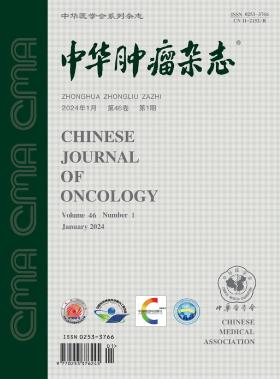[SIRT7对抑制胰腺癌细胞上皮-间质转化的作用及相关机制]
摘要
目的研究 SIRT7 在胰腺癌细胞上皮间质转化(EMT)中的作用及机制。方法用 siRNA 或质粒转染胰腺癌细胞,将其分为 siControl 组、siSIRT7 组、过表达 SIRT7 组、siSIRT7+siCOL4A1 组和 siSIRT7+siSLUG 组。分别用 EdU、伤口愈合实验和 Transwell 实验检测胰腺癌细胞的增殖、迁移和侵袭。通过实时逆转录聚合酶链反应定量分析(qRT-PCR)和蛋白印迹检测EMT和癌症干细胞(CSC)标记物的表达。对敲除SIRT7的PANC-1细胞进行RNA测序(RNA-seq),以探索SIRT7调控的信号通路和靶基因。然后通过染色质免疫共沉淀定量实验(q-ChIP)和染色质免疫共沉淀聚合酶链反应(ChIP-PCR)确定了 SIRT7 直接调控的靶基因。免疫组化(IHC)检测了胰腺癌组织中SIRT7和靶基因的表达,并利用TCGA数据集分析了SIRT7和靶基因表达的相关性。在 KM-plotter 网站上分析了 SIRT7 或靶基因表达与生存期的相关性。最后,利用GeneMANIA、STRING和ENCORI预测SIRT7相关蛋白和miRNA。结果EdU检测显示,SIRT7表达组PANC-1细胞[(19.33±0.35)%]和BxPC-3细胞[(17.00±1.89)%]的增殖率低于对照组[(31.60±1.37)%和(24.33±0.78)%,P<0.05]。SIRT7敲除组 PANC-1 细胞[(23.94±1.00)%和(27.08±0.97)%]和 BxPC-3 细胞[(22.00±1.86)%和(25.96±1.61)%]的增殖率分别高于 siControl 组[(11.80±1.86)%和(13.42±1.39)%,P<0.05]。在 PANC-1 细胞中,伤口愈合试验表明,SIRT7 表达组细胞的相对迁移率[(76.67±2.74)%]低于对照组细胞[(100.00±2.13)%,P<0.05];SIRT7敲除组细胞的相对迁移率[(134.22±4.08)%和(199.82±9.20)%]分别高于siControl组[(102.24±3.13)%,P<0.05]。与对照组相比,SIRT7过表达组BxPC-3细胞迁移数减少(45.66±1.69 vs 28.33±2.62,P<0.05);而SIRT7敲除组BxPC-3细胞迁移数增加(65.66±2.86和82.00±2.94 vs 33.00±0.81,P<0.01)。Transwell实验显示,SIRT7过表达组的侵袭细胞数(16.33±2.05 和 34.66±1.69)低于对照组(54.33±4.64 和 58.66±5.90,P<0.05);敲除 SIRT7 后,被侵染的 PANC-1 细胞(63.66±2.49 和 69.33±3.29)和 BxPC-3 细胞(134.33±3.09 和 181.66±4.02)的数量高于对照组(35.33±2.49 和 42.00±0.81,P˂0.05)。此外,SIRT7敲除还降低了上皮标志物的表达,增加了间质和 CSC 标志物的表达。RNA-seq分析表明,SIRT7参与调控多种癌症相关信号通路,包括胰腺癌通路和EMT通路。此外,SIRT7还能直接与COL4A1和SLUG等靶基因的启动子区域结合。SIRT7与胰腺癌细胞中COL4A1和SLUG的表达和功能呈负相关。通过 IHC 验证了 SIRT7、COL4A1、SLUG 和 SOX2 在胰腺癌组织中的表达。最后,根据 GeneMANIA、STRING 和 ENCORI 在线工具预测,SIRT7 与许多蛋白质和 miRNA 相关。结论SIRT7 可通过转录抑制 COL4A1 和 SLUG 等靶基因的表达来抑制胰腺癌细胞的 EMT。因此,SIRT7 可能是胰腺癌的潜在抑癌基因。Objective: To investigate the effect and mechanism of SIRT7 in epithelial mesenchymal transformation (EMT) of pancreatic cancer cells. Methods: The pancreatic cancer cells were divided into siControl, siSIRT7, over-expression SIRT7, siSIRT7+siCOL4A1, and siSIRT7+siSLUG groups using siRNA or plasmid transfection. The proliferation, migration and invasion of pancreatic cancer cells were detected by EdU, wound healing assay and Transwell experiments, respectively. The expression of EMT and cancer stem cell (CSC) markers were detected by quantitative real-time reverse transcription polymerase chain reaction assay (qRT-PCR) and western blot. RNA sequencing (RNA-seq) in SIRT7 knockdown PANC-1 cells was performed to explore the signaling pathways and target genes regulated by SIRT7. Then the target genes directly regulated by SIRT7 were identified with quantitative chromatin immunoprecipitation experiment (q-ChIP) and chromatin immunoprecipitation polymerase chain reaction (ChIP-PCR). The expressions of SIRT7 and target genes were detected by immunohistochemical (IHC) in pancreatic cancer tissues, and the correlation between SIRT7 and target gene expression was analyzed using TCGA dataset. The correlation between expression of SIRT7 or target genes and survival was analyzed on KM-plotter website. Finally, GeneMANIA, STRING and ENCORI were used to predict SIRT7-related proteins and miRNAs. Results: EdU assay showed that the cell proliferation rates in SIRT7-overexpressed PANC-1 [(19.33±0.35)%] and BxPC-3 cells [(17.00±1.89)%] were lower than those in the control group [(31.60±1.37)% and (24.33±0.78)%, respectively, P<0.05]. The proliferation rates of SIRT7-knockdown PANC-1 [(23.94±1.00)% and (27.08±0.97)%] and BxPC-3 cells [(22.00±1.86)% and (25.96±1.61)%] were higher than those of the siControl group [(11.80±1.86)% and (13.42±1.39)%, respectively, P<0.05]. In PANC-1 cells, the wound healing assay showed that the relative migration rate of SIRT7-overexpression cells [(76.67±2.74)%] was lower than that of control cells [(100.00±2.13)%, P<0.05]; the relative migration rate of cells with SIRT7 knockdown [(134.22±4.08)% and (199.82±9.20)%, respectively] was higher than that of siControl group [(102.24±3.13)%, P<0.05]. Compared with the control group, SIRT7 overexpression decreased the number of migrated BxPC-3 cells (45.66±1.69 vs 28.33±2.62, P<0.05); while SIRT7 knockdown increased these numbers (65.66±2.86 and 82.00±2.94 versus 33.00±0.81, P<0.01). Transwell experiment revealed that the number of invaded cells in SIRT7 overexpression groups (16.33±2.05 and 34.66±1.69) was lower than that control groups (54.33±4.64 and 58.66±5.90, P<0.05); with SIRT7 knockdown, the numbers of invaded PANC-1 (63.66±2.49 and 69.33±3.29) and BxPC-3 cells (134.33±3.09 and 181.66±4.02) were higher than those in control groups (35.33±2.49 and 42.00±0.81, P˂0.05). Also, SIRT7 knockdown decreased the expressions of epithelial markers and increased the expressions of mesenchymal and CSC markers. RNA-seq analysis showed that SIRT7 was involved in regulating a variety of cancer-related signaling pathways, including the pancreatic cancer pathway and the EMT pathway. Furthermore, SIRT7 could directly bind to the promoter regions of target genes, such as COL4A1 and SLUG. SIRT7 was negatively correlated with the expression and function of COL4A1 and SLUG in pancreatic cancer cells. The expressions of SIRT7, COL4A1, SLUG and SOX2 were verified in pancreatic cancer tissues by IHC. Finally, SIRT7 was predicted to be associated with many proteins and miRNAs based on GeneMANIA, STRING, and ENCORI online tools. Conclusions: SIRT7 can inhibit the EMT of pancreatic cancer cells through transcriptionally inhibiting the expression of target genes, such as COL4A1 and SLUG. Thus, SIRT7 may serve as a potential tumor suppressor gene in pancreatic cancer.

 求助内容:
求助内容: 应助结果提醒方式:
应助结果提醒方式:


